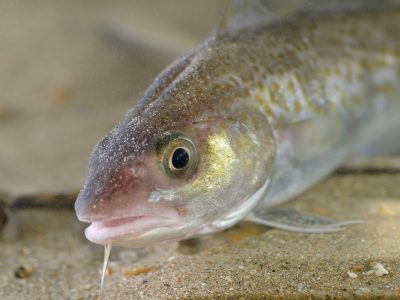At its peak in the 1960s, Newfoundland and Labrador’s Northern cod fishery employed more than 40,000 people and comprised hundreds of thousands of tonnes of catch, making it one of the world’s largest fishing operations. However, during the 70s, and again during the early 90s, the stock plummeted—mostly due to overfishing—forcing the Canadian government in 1992 to place a moratorium on catching northern cod and devastating Newfoundland and Labrador’s economy.
Now, three decades later, northern cod stocks are still critically low. Scientists debate how to rebuild the fishery, and whether doing so is even possible.

© Hans Hillewaert CC BY-SA 4.0
Questions about how to make this iconic fishery prosperous again have driven Institute for the Oceans and Fisheries (IOF) professor Dr. George Rose’s research for the past 30 years. A recently-published study by Rose and co-author Dr. Sherrylynn Rowe, a researcher from the Fisheries and Marine Institute of Memorial University, may provide some answers. It used findings from scientific publications going back to the 1920s as well as observations from Rose’s many years of field work in the province to outline historical northern cod spawning areas off the coast of Newfoundland and Labrador.
“We tried to tell a story in this paper about what happened to the northern cod since the 1960s, because there are some holes in the prevailing story that need to be addressed,” Rose said.
In the 1960s, fishing fleets from the former Soviet Union and many European countries arrived in the far north waters near Labrador, where they caught the best part of two million tonnes of fish in just two years. Such a tremendous haul indicates that cod were spawning in Labrador’s far north, and most researchers believe that these fleets severely overfished the stock, an event that may have precipitated the downfall of Eastern Canada’s cod industry.
The research team’s deep dive through dozens of pre-2000s surveys, stock assessments and studies, performed by both Canadian and European researchers, seems to confirm this version of events.
“The old studies showed very clearly, looking at the data, that most of the spawning back in the 1960s, when the stock was really strong and supported that huge fishery, was happening as far north as Saglek Bank, and not off the banks of southern Labrador and the northeast coast of Newfoundland, as has been proposed in more recent studies,”
Rose said. “All of the scientists involved at the time were in agreement that the main spawning areas of this stock were in the far north. It stands out like a sore thumb. If that’s the case, we’ve basically had a shift in the distribution of spawning from north to south.”

© Hans Petter Fjeld CC BY-SA 2.5
This shift could be the reason that Atlantic cod stocks have remained stubbornly low, Rose said. The Labrador Current, which runs north to south along Canada’s East Coast, may have transported cod eggs laid by spawning fish in the north of Labrador all the way down to the southern edges of Newfoundland.
“It’s almost like a conveyor belt from north to south in this ecosystem,” he said. “But if cod spawn in the south, there’s very little room for their eggs and larvae to go. Many will just be lost, or they certainly won’t go in the range we think of as being suitable for northern cod.”
In order for rebuilding efforts to be successful, they must encompass all of Newfoundland and Labrador’s coast, Rose said. Current rebuilding strategies are primarily focused on the south.
“The evidence is that production from a southerly distributed stock is unlikely to ever reach the levels sustained by a full portfolio of spawning from north to south,” he said.
Rose thinks that future studies on many topics could benefit from a close look at old research, which too often gets ignored.
“You have to show scientific skepticism about everything, but we should use both the data and the analyses done by people who were there and observing this at the time,” he said. “They didn’t know everything, any more than we do, but they had the advantage of being there, and at sea, seeing this and watching what was going on first-hand.”
The study “Congruence of stock production and assessment areas? An historical perspective on Canada’s iconic Northern cod” was published in the Canadian Journal of Fisheries and Aquatic Sciences.